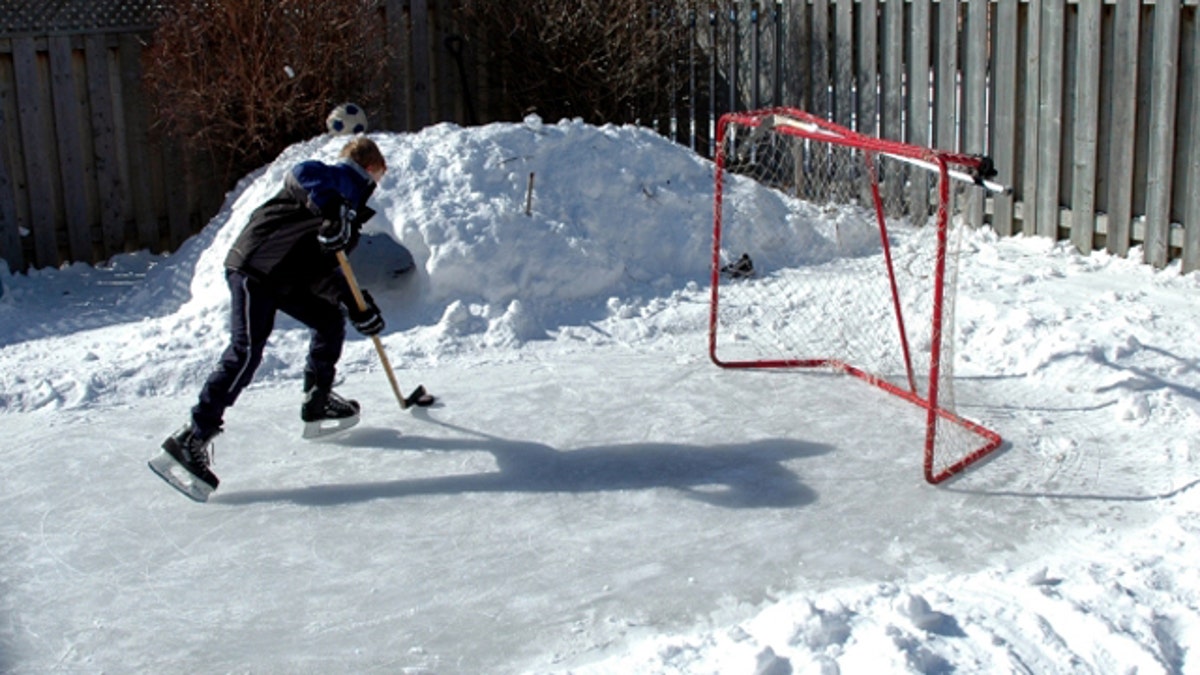
(iStock)
Back in the days before lawsuits were fashionable, municipalities in cold-winter climates used to flood parks and ball fields to create outdoor ice rinks for the local kids. What could be better than getting home from school, suiting up and heading down to the park with your skates slung over your shoulder? These days ice skating isn't so simple. Like most modern recreation, it involves driving, membership fees, limited hours and, of course, lots of rules. Worst of all, it's indoors, and anyone who likes winter sports knows that being out there in the cold air is what it's all about. A backyard skating rink instantly brings back the magic of outdoor ice skating-and it's a great way to get the kids out of the house during those long days of winter breaks.
Types of Backyard Rinks
Whether your goal is to foster the next Gretzky or Hamill, or if you just plan to slide around in your boots with the little ones (and try not to break your hip), you can build your own rink in a few different ways. The traditional method is to create a packed snow bank encircling the rink and then flood the interior with water. The drawback of this design is that unless you live near or north of Fargo, warm winter days will undermine the banks and let out any melted ice (water, that is). At the other end of the spectrum, you can purchase prefab ice rink materials and accessories a la carte or as in-a-box sets. You can even buy refrigerated systems for extending the skating season into the spring (ironically, thanks to all the electricity you'd be using, spring might come a little earlier each year). But the best type of rink for most DIYers is, like so many homegrown projects, made with good old plywood.
Modular Plywood Ice Rink
In this case, "modular" means that you can build the rink walls in sections for easy transport and storage. Start by ripping full 4 x 8-foot sheets of 3/4-inch CDX (exterior) plywood into planks anywhere from about 8 to 24 inches wide. For each 8-foot section of wall, build four triangular braces, using 2x6 lumber. The front (wall-side) and bottom legs of the triangle form a right angle, while the third leg runs at a 45-degree angle between the top and bottom legs. If desired, paint the plywood and braces with two coats of exterior house paint (preferably white, so it blends in with your backyard winter wonderland).
Fasten the plywood planks to the braces with deck screws, spacing the braces about 2 feet apart. Position one outside brace so it overhangs the end of each panel by 2-3/4 inches (half the width of a 2x6), and set the other outside brace 2-3/4 inches in from the opposite panel edge; this allows you to overlap and secure adjacent wall sections when assembling the rink. Add lumber blocking behind the panel edges that will form the corners of the rink. You can also build 4-foot-long wall sections, each with three braces, for forming corners or fitting your rink space, as needed.
Completing the Rink
Fit the wall sections together to create the rink perimeter, joining adjacent sections by screwing along the overlapping joints. Cover the entire rink in a single sheet of 6-mil clear plastic sheeting (it's available in huge pieces through specialty plastics suppliers and retailers of backyard ice rink equipment). Drape the plastic along the inside face and up and over the wall sections. Flood the rink interior with water to a minimum depth of 2 inches. If your yard slopes, the ice will be thicker in the lower areas, but that's ok; it just takes more water. Let the water freeze completely and you're ready to skate. Rewet the rink as needed to smooth the ice (there's no need to shop for a secondhand Zamboni).
Safety Notes
You can cover the top edges of the plywood wall panels with foam pipe insulation. Just slit the insulation tubes with a utility knife, cutting through just one wall of the tube in a straight line. Slip the tubes over the plywood edges, butting the tubes end-to-end to create a continuous safety rail. If your rink will be used for hockey or any other activity involving speeding projectiles, protect your house from flying pucks, either with tall rink walls or by locating the rink a safe distance away the house (and from your neighbors' houses).
For More Information
With all the hockey nuts in this country (and many, many more in Canada and other wintry areas), you can find loads of additional planning and construction advice for backyard rinks online. One of my favorites is mybackyardicerink.com. Happy skating!
Philip Schmidt is a Networx - http://www.networx.com - writer. Get home & garden ideas like this - http://www.networx.com/article/building-a-backyard-ice-skating-rink - on Networx.